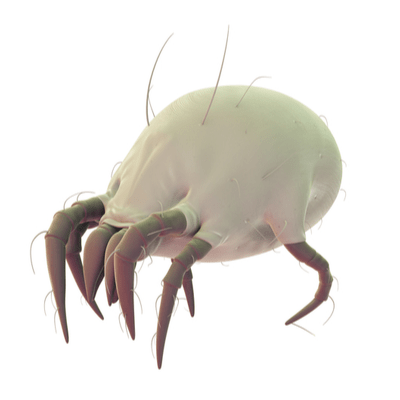Possible nesting sites for the mite include carpets, padded sofas and chairs, soft toys and especially bedding. Modern homes with high temperature, high humidity and lack of ventilation have been shown to be ideal breeding grounds.
House dust mites feed on dander (dead skin which is shed) from humans and animals. They may also feed on protein based foodstuffs, preferring dried products over products with moisture.
People may be allergic to house dust mite cast skins and droppings. These reactions will not be a rash type of reaction but rather a respiratory constriction, a common symptom of asthma. Itchy, watery eyes may also be symptoms. Approximately 50-80% of asthmatics may have symptoms due to house dust mites.
To eliminate dust mite allergens, first, take actions to reduce dust mite populations and second, reduce exposure to dust. No one method has been found for reducing mites and relieving allergy suffering.
LOWER HUMIDITY --
Reduce humidity levels to less than 50 percent inside your home, especially in the bedroom. This isn't hard to do in the winter, but can be a challenge in Nebraska during summer months, especially in homes without air conditioning. Studies have shown air-conditioned homes have ten times fewer dust mite allergens than non-air-conditioned homes. In addition to cooling the house, air conditioning reduces the humidity dust mites need to thrive. A study has shown using an electric blanket for eight hours each day reduced dust mites by 50 percent in one month.
AVOID FURRY OR FEATHERED PETS --
Pets with fur or feathers contribute to the dander in the dust and increase food source for mites. If you are a pet lover, locate their sleeping quarters as far from yours as possible and furnish their sleeping area so it can be cleaned easily. Hardwood or vinyl floors with washable area rugs are ideal.
REDUCING AIR INFILTRATION --
Airing out the house with open windows allows entry of pollen, which is another allergen as well as food for dust mites. In some climates, incoming air may be humid, which promotes dust mites.
CLEANING/HEAT TREATMENTS --
Wash all bedding weekly. Research has shown laundering with any detergent in warm water (77 degrees F) removes nearly all dust mite and cat allergen from bedding. If you cannot launder blankets, dry clean them once a year. Shampoo, steam clean or beat non-washable carpets once a year.
SELECT APPROPRIATE FURNISHINGS --
Avoid overstuffed furniture because it collects dust. Also avoid wool fabrics/rugs because wool sheds particles and is eaten by other insects. Use washable curtains and rugs instead of wall-to-wall carpeting. If you cannot replace carpeting, have it steam cleaned at least once a year, springtime is best. This will prevent a buildup of dust mites feeding on skin cells in the carpet during the summertime. Enclose mattresses and pillows in plastic to decrease mite populations in the bed. Replace feather pillows with synthetic ones.
Eliminating dust from the environment is important in reducing allergens in sensitive people.
VACUUMING --
The most important tool for managing house dust and dust mites is the vacuum cleaner. Regular, thorough vacuuming of carpets, furniture, textiles and other home furnishings such as draperies will help keep dust mite populations low. Vacuums with a water filter are preferable to those with a disposable paper bag because a water vacuum removes a greater range of particle sizes than paper-bag types. There are vacuums with highly efficient filters (HEPA) designed for use by people with allergies to dust. It is better to vacuum thoroughly once a week rather than lightly on a daily basis. Vacuum mattresses and padded furniture thoroughly; 20 minutes for each mattress is not too long.
DUSTING --
Dust furniture before you vacuum so the dust has time to settle on the floor, where it can be picked up by the vacuum. Do not scatter dust. Instead, dust with a damp cloth rather than dry dusting. Spraying furniture polish/dusting liquid directly on surface reduces airborne particles by 93 percent compared with dry dusting.
AIR PURIFERS --
A researcher at the University of Texas-Austin found a HEPA air filter was much more effective at removing dust than ion-generating air purifiers which make particles electrically charged to remove them from circulating air.





